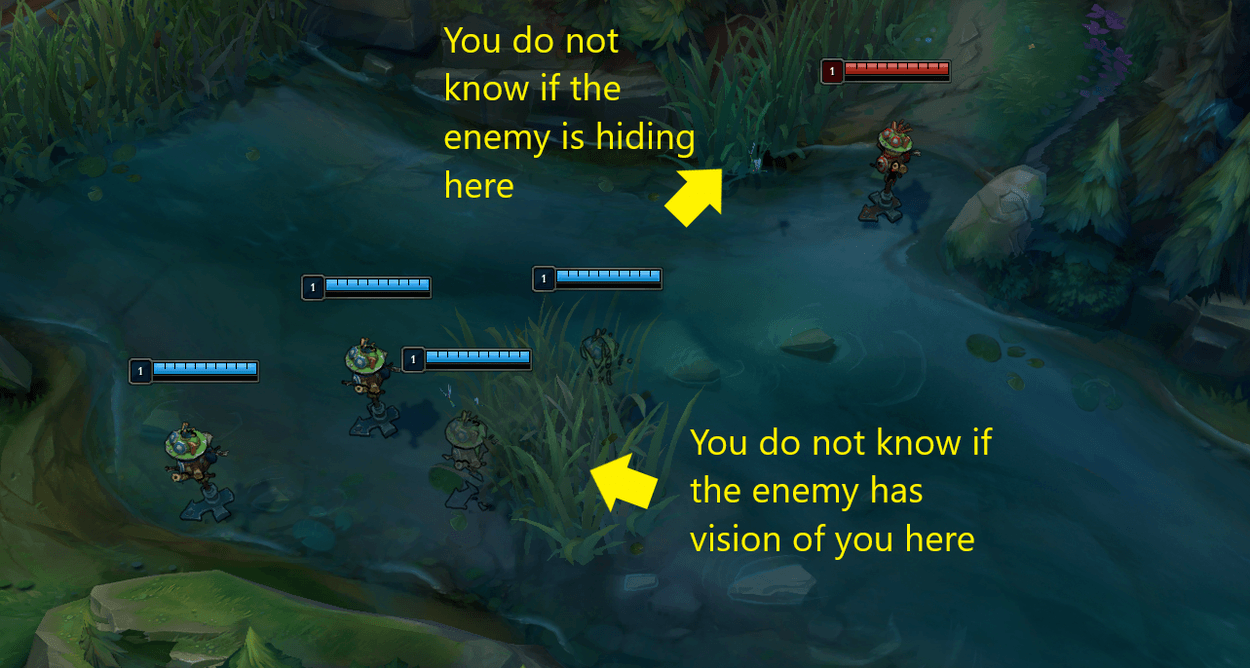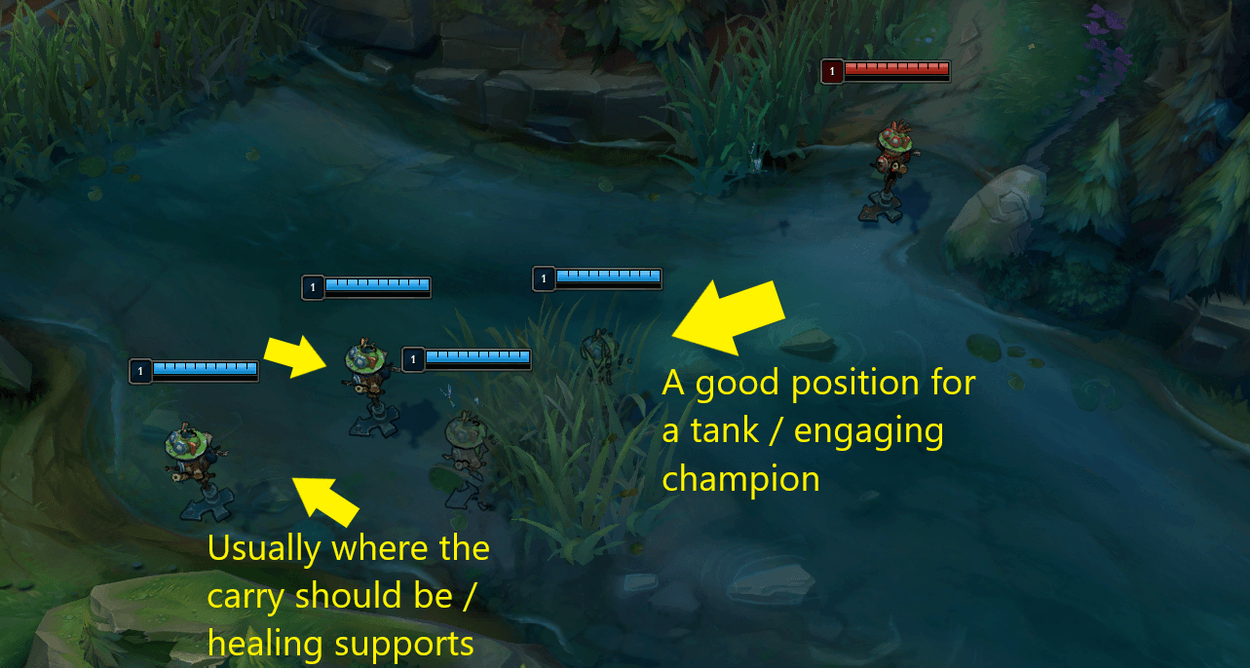How to Teamfight as a Support in League of Legends
Teamfights are the deciding factors to victory in League of Legends, and as the support, you may just have the say in who wins.
Teamfights are the deciding factors to victory in League of Legends, and as the support, you may just have the say in who wins.
During a teamfight there are many different situations that can arise, and the whole team needs to come together to do their part to ensure victory. The support role is no exception, and supports can sometimes have the most important tasks to carry out.
Most teamfights will occur around objectives, like the Dragon or Baron Nashor; no matter where the fight is, however, having vision of the area around you is a key factor in keeping an advantage over the enemy. As a support, you have access to more wards than your allies with the help of your support item, (Spellthief's Edge, Steel Shoulderguards, Relic Shield, or Spectral Sickle), so it is mainly your job to place vision around the map. It can often be hard to predict exactly when a teamfight will break out, so you will want to maintain vision at every chance you get.
While in bot lane, you will want to take a moment to place a ward in the river to keep watch for a gank from the enemy. As Dragon starts to spawn, you want to make sure you have a ward showing vision of the Dragon Pit; using a Control Ward or Oracle Lens on the Dragon Pit is also important. Having vision of objectives will keep you informed on whether or not the enemy is engaging on it, giving you a chance to either contest the objective or stay clear of the area. If you start to move in to engage on a teamfight and do not have vision of the area, you will not know where your enemy is positioned, giving them an easy opportunity to ambush you and emerge victorious. Alternatively, if you can clear the enemy's vision of the area before the fight, it will make it a lot harder for them to move in and engage.
Having vision of the area before a teamfight will help you see exactly how many enemy teammates are there, where their carries are located, and whether or not one of them could be caught out and shut down by themselves. Another example of this is having vision of an area where the enemy team is grouped up and ready to ambush, like a brush in the river, giving you a chance to use a crowd-controlling ability on the area and allowing for a quick shut down. So, as a support, you want to make sure you are placing vision whenever possible, as well as clearing enemy vision as you go, keeping your enemies in the dark. The reason vision is so important for a teamfight is because it gives you or your enemy ample time to decide how to engage.

Besides having vision, your position in the teamfight is another key factor to securing the victory. Depending on your champion, your desired position can vary, so it is important to know exactly what role you are designed to fulfill. Supports that are tankier and can engage on the enemy will want to be in the "front" of the team ready to either protect their allies or close in on the enemy champions. Alternatively, if you have a bruiser or tank top laner or jungler, they may also be positioned in the front and ready to engage, meaning that you should stay close to your carry to keep them protected while you wait for an opportunity to follow-up engage. If you are the only member of your team that can engage you will want to stay at the front but be sure to keep an eye on your carry in case you need to go back and peel for them.
Champions like Soraka, Lulu, or Nami, who are majorly designed to heal and shield their allies, should stay in the "back" of the team by their carries. Your job is to keep your carry safe and buffed up, while being able to throw your abilities out to either follow up with an engage or to protect other members of your team. You are not as strong as the tank supports in terms of health and armor, so being in the front of the fight will usually lead to you being an easy target for the enemy to shut down. If you are defeated so quickly, you will not be able to protect your allies, especially not your ADC. Either way, despite what champion you are playing, you want to stay close to your allies to avoid being caught out and alone. Keep in mind that you do not want to be bunched up together, right on top of each other, in the event the enemy lands a big AOE ability that can shut you and your allies down.

Depending on what champions you play, the support is usually the member of the team who engages on the enemy and initiates the teamfight. Champions like Nautilus, Thresh, or Blitzcrank can single out an enemy and keep them stunned while their team shuts them down. It is important that you single out the correct target, usually their ADC, someone doing high damage, or someone who is keeping their team alive with heals. It will be harder as well as less efficient if you target their tank; tanks have higher health pools and usually their own methods of crowd control, often leading to the enemy counter-engaging and winning the fight. You want to focus on the members of the team who can shut down your own carries and be the determining factor in the fight.
Mages and ADCs are easier to shut down than a champion bulked up with armor, so if the enemy team ends up having an extremely fed bruiser champion, it can be a lot harder to single them out and shut them down. In these situations, you will need a lot of follow-up crowd control to keep them from reacting to your engage so that you can defeat them. This makes it even harder if the rest of the team are there fighting you, so you will either want to teamfight when this champion is not nearby or try to catch them alone and overpower them.
Not all supports can make the direct engage for the team, especially if they are only designed to heal and shield. However, there are a few supports who can use crowd-controlling abilities in addition to other teammate's abilities to shut down a target. For example, Morgana or Lux can throw out their Q at the target, but it will usually require another team mate to attack with them to completely shut them down. Alternatively, Nami and Seraphine can use their Ultimate abilities to set up a large engage on multiple targets, but it will require other teammates to follow up with them to either defeat the targets or keep them crowd-controlled. Again, you want to try and isolate key members of the enemy team for your engage to be effective.
If someone else on your team engages, you can use your abilities to keep the target from escaping and help your team shut them down. If you do not have any abilities that can stun or otherwise disable your target, you can simply use your damaging abilities to break down their health or use your supportive abilities to shield and heal your allies who are engaging.
If your team was the one to engage, you will want to follow up with this engage and then assist your allies with either crowd-controlling abilities or healing and shielding abilities. Keeping your allies buffed or keeping your enemies shut down, depending on your champion, will be your goals throughout the teamfight. Always keep an eye on the carries of the enemy team, as they will want to target your carries, or they may even come for you. If you are a champion who heals and shields your allies, be sure to use such abilities on whoever is being damaged while keeping your mana pool stable enough to assist additional allies. Ideally, you want only one of your team mates to be attacked, but this usually will not be the case, especially in the event of a large AOE ability. You want to know who to priortize during a fight, like throwing a heal on the bruiser who is taking the bulk of the damage or buffing up the carry who is laying waste to the enemy. Keep in mind that if you do not have any abilities to use on your enemies, you can always use your auto attacks to help beat down their health bars.
If the enemy team was the one to engage instead, you have to make a quick decision whether or not you can save the ally who has been engaged on. If your ally is a tank or a bruiser, you can usually throw shields and heals on them to bring them back from the brink of death. However, if your ally was a weaker target, like a mage or your ADC, you usually cannot save them from an ambush, and it is best to disengage and back away from the area. Once your ally has been defeated, and you now are left at a disadvantage in numbers, you should avoid counter-engaging since the enemy now has more members who are ready to fight. You will only be able to re-engage if you somehow caught one of their members out like they did with yours, or if you can stay back and poke them down before closing in on them.
Once you have engaged on the enemy team you want to be sure you are keeping up with your advantage, and if you are losing your advantage, you need to know when to disengage. You want to limit how many fights you take with a disadvantage in numbers, aiming to always fight on equal or higher ground. If you lose this ground and your allies start to drop, you need to be able to cut your losses and retreat to limit your casualties. You want to help your allies disengage by keeping them protected at all costs, even if it means sacrificing yourself to keep the majority of your team alive. If the enemy was only able to defeat you, the support, but your carry was able to safely shut them down and secure the win, then the fight will still be worthwhile.
After the fight has settled and your allies emerge victorious, be sure to return to the objective and finish securing it, (if it has not been secured yet). Once the objective has been claimed you will usually want to return to base and recuperate from the fight so your enemy can not respawn and shut you down. If you are still healthy after the fight you can use this opportunity to control the vision of the area and assist your allies with their next decision.
However, if you were not successful in the fight, use this opportunity to figure out what went wrong so that you can improve on it when the next fight occurs. You can start setting up vision for the next area of interest and return to the side of your ADC to assist them in what comes next.
As a support, you have many different important tasks to fulfill in order to secure the victory for you and your allies. Keeping your team protected, keeping your enemies at bay, and controlling the vision of the map are key goals to being a successful support. It is important that you stay close to your allies and be ready to assist them throughout the course of every teamfight.